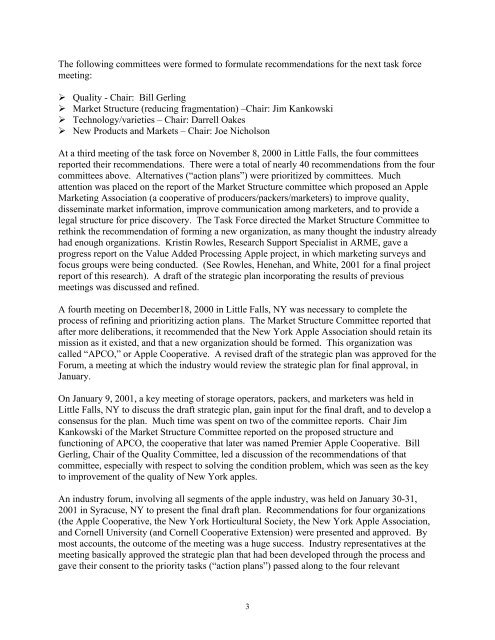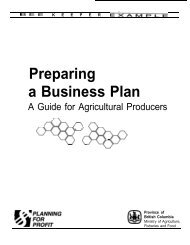Gerald B. White - Agricultural Marketing
Gerald B. White - Agricultural Marketing
Gerald B. White - Agricultural Marketing
You also want an ePaper? Increase the reach of your titles
YUMPU automatically turns print PDFs into web optimized ePapers that Google loves.
The following committees were formed to formulate recommendations for the next task force<br />
meeting:<br />
Quality - Chair: Bill Gerling<br />
Market Structure (reducing fragmentation) –Chair: Jim Kankowski<br />
Technology/varieties – Chair: Darrell Oakes<br />
New Products and Markets – Chair: Joe Nicholson<br />
At a third meeting of the task force on November 8, 2000 in Little Falls, the four committees<br />
reported their recommendations. There were a total of nearly 40 recommendations from the four<br />
committees above. Alternatives (“action plans”) were prioritized by committees. Much<br />
attention was placed on the report of the Market Structure committee which proposed an Apple<br />
<strong>Marketing</strong> Association (a cooperative of producers/packers/marketers) to improve quality,<br />
disseminate market information, improve communication among marketers, and to provide a<br />
legal structure for price discovery. The Task Force directed the Market Structure Committee to<br />
rethink the recommendation of forming a new organization, as many thought the industry already<br />
had enough organizations. Kristin Rowles, Research Support Specialist in ARME, gave a<br />
progress report on the Value Added Processing Apple project, in which marketing surveys and<br />
focus groups were being conducted. (See Rowles, Henehan, and <strong>White</strong>, 2001 for a final project<br />
report of this research). A draft of the strategic plan incorporating the results of previous<br />
meetings was discussed and refined.<br />
A fourth meeting on December18, 2000 in Little Falls, NY was necessary to complete the<br />
process of refining and prioritizing action plans. The Market Structure Committee reported that<br />
after more deliberations, it recommended that the New York Apple Association should retain its<br />
mission as it existed, and that a new organization should be formed. This organization was<br />
called “APCO,” or Apple Cooperative. A revised draft of the strategic plan was approved for the<br />
Forum, a meeting at which the industry would review the strategic plan for final approval, in<br />
January.<br />
On January 9, 2001, a key meeting of storage operators, packers, and marketers was held in<br />
Little Falls, NY to discuss the draft strategic plan, gain input for the final draft, and to develop a<br />
consensus for the plan. Much time was spent on two of the committee reports. Chair Jim<br />
Kankowski of the Market Structure Committee reported on the proposed structure and<br />
functioning of APCO, the cooperative that later was named Premier Apple Cooperative. Bill<br />
Gerling, Chair of the Quality Committee, led a discussion of the recommendations of that<br />
committee, especially with respect to solving the condition problem, which was seen as the key<br />
to improvement of the quality of New York apples.<br />
An industry forum, involving all segments of the apple industry, was held on January 30-31,<br />
2001 in Syracuse, NY to present the final draft plan. Recommendations for four organizations<br />
(the Apple Cooperative, the New York Horticultural Society, the New York Apple Association,<br />
and Cornell University (and Cornell Cooperative Extension) were presented and approved. By<br />
most accounts, the outcome of the meeting was a huge success. Industry representatives at the<br />
meeting basically approved the strategic plan that had been developed through the process and<br />
gave their consent to the priority tasks (“action plans”) passed along to the four relevant<br />
3




